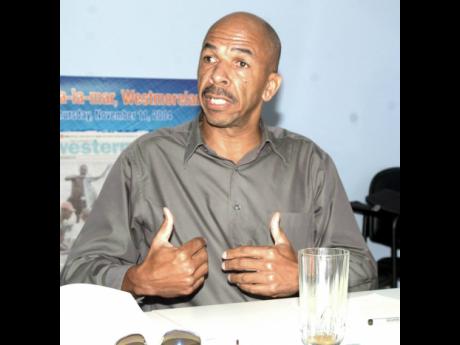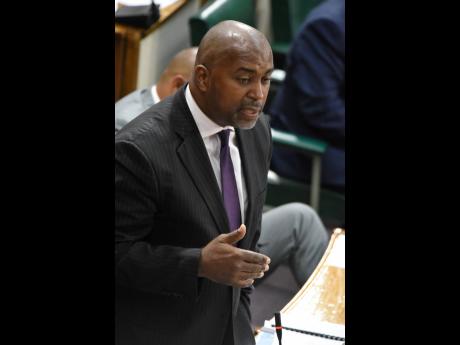Explosion of building projects in the city? Live with it, says NEPA
Mikael Phillips, Opposition spokesperson on transport, housing, and works, has voiced support for advocates’ call for the Government to not confirm the provisional development order (PDO) of 2017 without first consulting affected residents who are being hemmed in by the increase of high-rise buildings that are enclosing single-family homes.
In an open letter addressed to Prime Minister Andrew Holness on Monday, representatives of 29 citizens’ associations and other individuals of communities like: Eastwood Park Gardens, Liguanea and Molynes Gardens, have expressed discontent with the lack of transparency of the Government regarding the development approval processes of high-rise apartment buildings being constructed in residential neighbourhoods across the Corporate Area.
This letter is among several others which have been sent to stakeholders such as the Kingston and St Andrew Municipal Corporation (KSMAC) and the National Environment and Planning Agency (NEPA) outlining the issues faced by residents.
Hugh Dixon, a representative of the Queensway Citizens Association, told The Gleaner on Tuesday that the umbrella group, Citizens Rights to the City (CRC), which unites the 29 associations, is requesting the Government to postpone its plan to confirm the PDO for five years so that locals can participate in the necessary amendments to be made in response to findings and recommendations submitted.
Some of the negative effects residents have had to endure include: increased traffic and noise levels, decreased green spaces; loss of privacy by homeowners, the blockage of natural air flow and light, increased run-off from paved surfaces adding to more flooding concerns, increased garbage and more pressure on already inadequate water supplies.
Dixon said that along Charlemont Drive alone, there were at least eight approvals for construction to take place which have either commenced or are about to commence.
“You are at home and all of a sudden you see a fence put up next door to you, blocking out the view and then you realise that construction is going to go there and on the other side, one month you wake up and then two high-rise structures beside you,” he said.
“A lot of the buildings that are going up are in breach because what has happened is that you have approvals being given, for example, 12 habitable rooms but these guys are so skilful that they submit a 12-room thing [but] subdivide it and make it 24,” he added.
In an interview with The Gleaner on Wednesday, Phillips said that he supported the citizens’ reasoning and that he is suggesting to Holness to review the order before putting it in permanency “because there are some things that will work and some things that won’t work”.
In a meeting of Parliament’s Infrastructure and Physical Development Committee on November 30, representatives of the CRC were only permitted to sit in the Parliament’s gallery and were not allowed to participate in the discussions being had or to present their issues and to voice their recommendations.
Phillips bemoaned this, stating that this move by chairman of the committee, Heroy Clarke, was “disingenuous” and “deliberate” and that he had “dropped the ball” on allowing the voice of the residents to be heard and to bring value to the meeting.
Within the meeting, Clarke stated that residents were to take up their issues with the municipal cooperation who, he said, has the last say in accepting any recommendations submitted.
“All planning, all building infrastructural development has a place at the local authority which is the municipal corporation in this matter, that is my take on it,” he said.
Head of NEPA, Peter Knight, who was also present at the meeting, stated that citizens could not expect to live in a city and not witness orderly development taking place.
“Any city in the world, you look around ... cities develop around you. You may wish not to be part of the development of the city and you may want to move further to the suburbs [and] that is fine, but a city is going to develop around you,” he said.
He stated that the development order allows the Government to promote increased densities and heights of buildings. Knight noted that 19 major “growth centres” had been identified within the KSAMC along with major corridors and nodes for development.
“We are allowing higher densities in the main local planning areas such as downtown (Kingston), New Kingston, Half-Way Tree, Constant Spring, Hagley Park, Camp Road, to name a few,” Knight listed, while noting that the order also aimed at promoting sustainable development, economic growth and protection of the environment.
Knight emphasised that a wide range of organisations, including the town and country planning authority, the Kingston and St Andrew Municipal Corporation (KSAMC), community organisations, community associations, professional organisations, and other governmental bodies, would worked together to create a new development order.
Phillips told The Gleaner that while he agreed with Knight that the city should experience more development, it must also take into account the needs of residents and the environment, and not just because the order calls for the construction of multistorey homes with 100 habitable rooms per acre.
In the letter, the representatives expressed that “several communities have had an explosion in multistorey, residential development and commercial activity. The volume and pace are far ahead of the capacity of the KSAMC and other agencies to ensure compliance with building and planning laws ... resulting in widespread breaches.”
Xavier Chevannes, chief technical officer within the KSMAC, disclosed in the committee meeting that of 183 developments carried out between January and March, over 30 of them were built without the approval of the KSMAC.
He continued that of that amount, 14 developers were issued cease to work orders, 13 were being investigated and eight were deemed as special operations.
In an update provided, Chevannes revealed that 60 per cent of the developments sought to be regularised, 25 per cent had stopped construction and another 25 per cent of them had ignored the cease to work order issued.
Phillips, on the matter of the illegal construction of buildings, told The Gleaner that more assistant building officers needed to be employed to help in enforcing the law as this was where the weakness lay.
“You can have all the laws on the books but if you are not enforcing it, you won’t get the desired results, and that is what we are seeing, not only in Kingston and St Andrew, where majority of developments are taking place, but it’s right across the country, and we know our culture, if we give a man a little ease, a little break, he is going to take it,” he said.
Dixon said that one of the biggest issues that residents face was the cost of taking legal action against the developers who are in breach.
Julian Robinson, member of parliament for St Andrew South Eastern, addressed the issue of developments without consultation.
“Certainly, I can say for my constituency it is rare that a consultation is held [with residents] and where it is held, there’ve been a number of issues raised about the lack of appropriate notice,” he said in the committee meeting.
Dixon told The Gleaner that his citizens’ association had held a meeting with the developers some weeks ago and informed them that while they had no issues with the development, “they ensured to express that the developments had to maintain the integrity of the environment in which they lived”, he said.
The CRC is calling on the NEPA, Natural Resources Conservation Authority, and the KSAMC to make available for easy online access by citizens, up-to-date records of all building applications, including outline planning permission, permit numbers of pending developments, results of applications (approved, denied or modified), stop orders and inspection reports.






